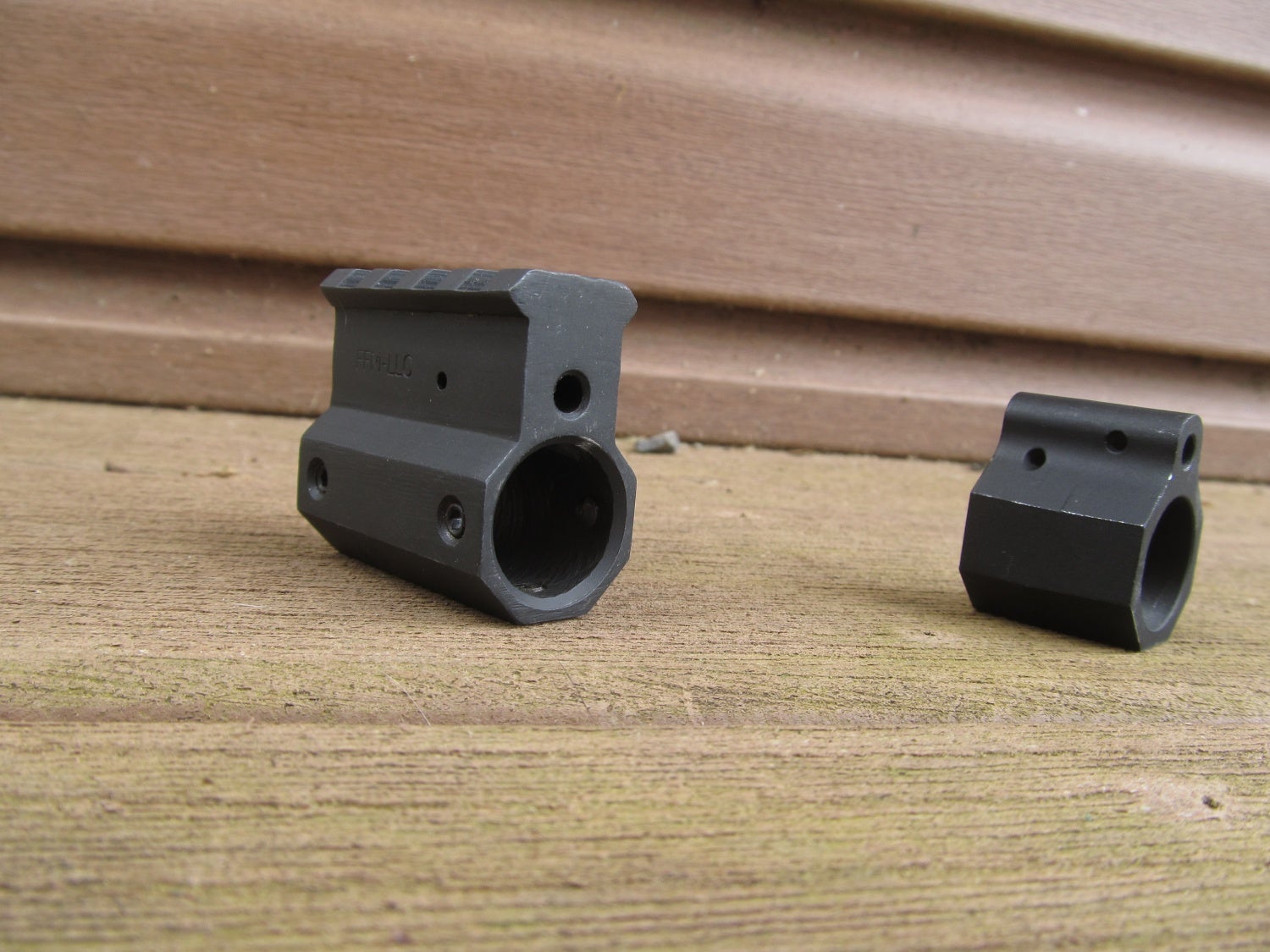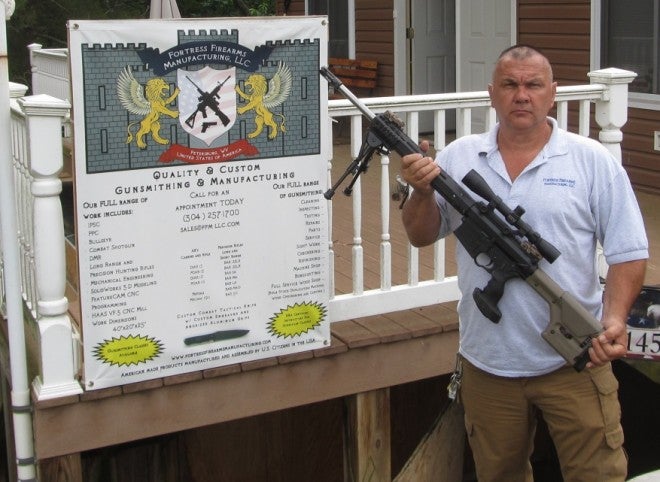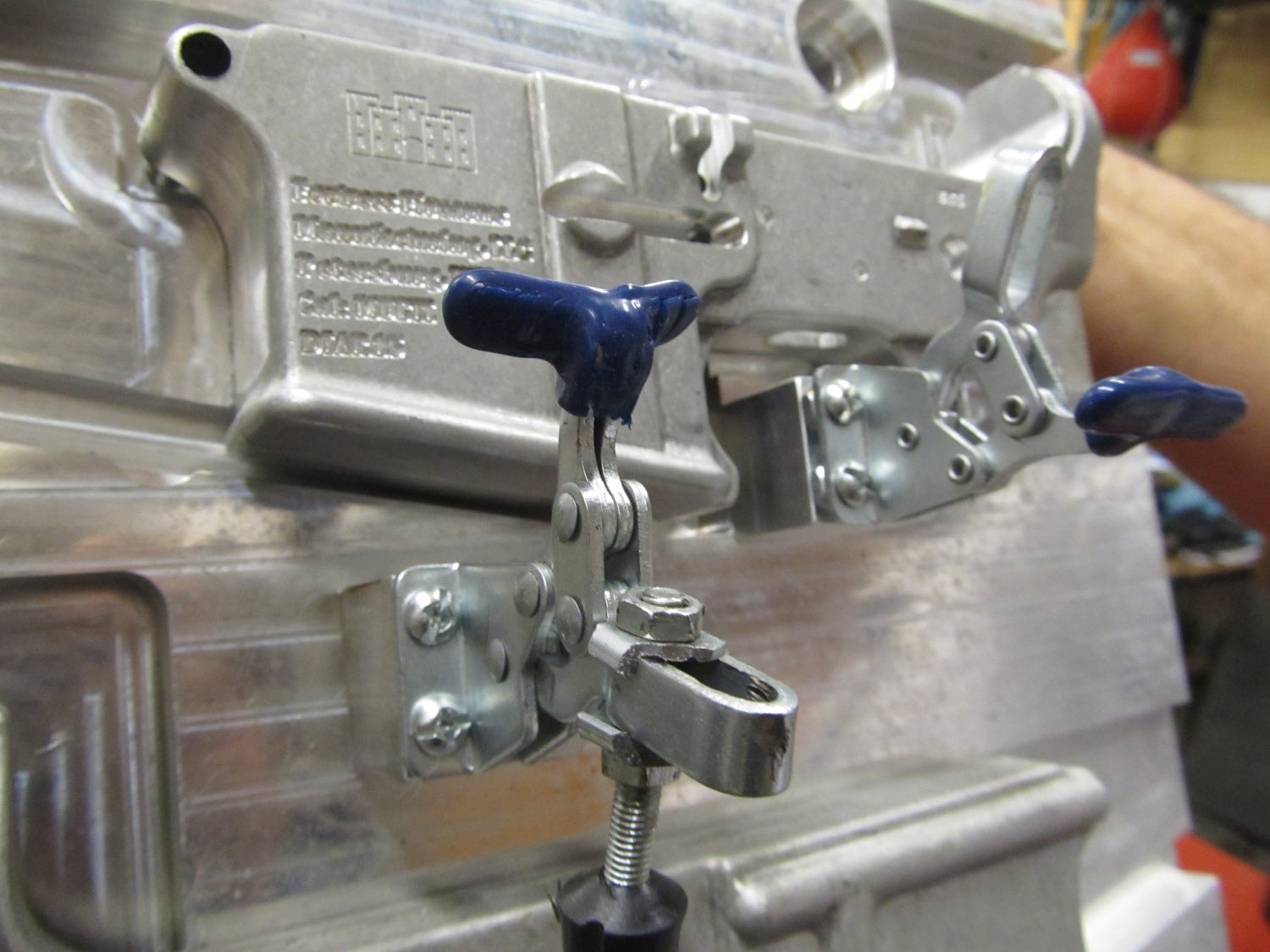Thomas Kivlehan Jr is a retired Marine 2112. In other words, he knows a thing or two about how to manufacture and maintain firearms of all types. The majority of his accomplishments come from being in the Precision Weapons Section in Marine Corps Base Quanitco, Virginia. There, the section produces all the M40s in use by Scout Sniper platoons, refines all the match weapons in use by the shooting teams, and tests various weapons for the Marine Corps, in addition to providing guidance on how to maintain them and so on. Unlike other military occupational specialties, the 2112s aren’t something a Marine can just be assigned to. They have to prove themselves as a 2111, and then pass a rigorous school in which some of their final tests involve making 1911s, M14s, and M40s from scratch.
After he retired from the Marine Corps, Thomas worked for a number of different companies in the industry. These include Hecklor & Koch, LWRC, FN Herstal, Kimber, Black Heart International, and Marine Corps Systems Command as a civilian. His achievements range from refining the MEUSOC .45 in the 1990s, working on the initial Barrett M82s, the Kimber rimfire rifles, pretty much designed the FN Special Purpose Rifle, in addition to being directly involved with the testing of most designs within the military in the 1990s. These include the OICW, the experimental M16A3s/A4s, M240B, Benelli M104, and many more.
However, not to be content with just working on other people’s stuff, he decided to start his own company called Fortress Firearms Manufacturing, out of Petersburg, West Virginia. That is where I ran into him and had a chance to talk about his company. Currently they focus on the AR platform, but are going to be bringing precision long guns and .22 bolt action rifles to the table.
The Firearm Blog- So can you start with why you began this company?
Thomas Kivlehan- The prime motivations for me starting my own gun making business in West Virginia ties into the reasons I’ve left a number of other companies in the industry. I’m tired of seeing things being outsourced, designs being stolen, cutting corners, straight up lying, loans never getting paid, people taking false credit for things that were really team efforts. By having my own company, I cut through all that immediately. I want to be known for quality and reliability and American manufacturing with US citizens.
TFB- How do you plan on proving this commandment to industry and American gun owners? In other words, what makes your ARs stand out from every other company’s ARs on the market?
TK- First of all, there are a lot of good people and good companies making guns the right way. There are a lot of guys that are doing what they say they do. But then there’s some people that start out doing that, but then scale back by doing the above, cutting corners, etc… They do this for whatever reason, and in my opinion those reasons are not for the consumer; they’re for the share holders, or the bean counters, counting the profit. That’s not why I’m here, I mean yes, I have to make money. But quality, reliability, and my customer come first. I want to be able to sell you a gun that will last, or outlast, your lifetime. That’s the name of the game. The other thing is the right materials and right products. There’s always new material that is out there-better, more durable, and so on. I’d love to get involved with it. But the same thing, it has to be proven to me first. There’s a reason why we build ARs on 7075 T6 aluminum. There’s a reason why other people use 6061; it’s cheaper. Is it better? No… And do they lie about it? Yes… I go to shops all the time. And I’ll look at stuff, and I’ll see exactly what it is. It’s stamped on the box what kind of material it is before the machining process. I’ve gotten stuff before and I’ll say something is wrong with this. It’s not as hard as 7075. It’s cutting like butter. What’s up with that? Oh it’s 6061… You just have to make sure you get the right material. The problem is there are a lot of consumers out there that don’t know this. They look at ARs in a row and the only thing they look at is the price tag. They don’t look at triggers in it, what kind of barrels are in it, or what type of furniture is on it (handguard, stock, grip, etc). Mostly, is it a mil spec bolt carrier and is it a match grade barrel. There are a lot of guys out there building cheap barrels. You know you get some for 50-60 bucks. For real barrels, it’s harder to get the material for that. So a lot of these manufacturers are selling cheap guns for that reason. Once in a while I will get a customer that comes in and says he saw an AR15 for $400 and will give me $400 for a rifle that is clearly marked $1,100, so I explain why my rifle is what it is and maybe he should have bought the other rifle if this is what he is looking for, $400 rifle, which is not the same. All my parts are American made, I make sure of this, I also conduct quality control checks on every part I receive and I test fire every gun we assemble and I stand behind everything we do, period!
TFB- What about some of the unique parts your company is coming out with?
TK- My thing is Mil Std 1913 scope mounts. There are a lot of people out there making them. I had a lot to do with it in the Marine Corps. I just think that a lot of people that are involved with it and selling them are kind of overpriced. Machining practices and what I do, I keep a thousandth tolerance or better on all my parts on most everything that I do. On some of them I do a 10th of a thousandth. I see some guys selling these scope mounts for 200, 250. Why? There’s no reason why it can’t be half of that. It’s a part, and it’s CNC machined. There’s nothing special about it. That’s 4140, 4150 steel. Same thing with uppers and lowers-there’s guys out there selling lowers for 250 bucks. Why? I don’t understand it. Gas blocks-the same thing. Adjustable gas blocks, which only have threaded holes, are 40-50 bucks more for a threaded hole. That’s ridiculous. We also have a PKM folding stock block. I can’t take all the credit for it. We were at Black Heart and they asked me if we could do it and we did. It actually originated from an Army contract or something. I’m waiting for Black Heart to say if they want to continue with them or not because we can make them. We also have bipod rails for stocks. I haven’t found anybody that makes them. My Kimber inventory has them and Parker Hale rifles have them as well. Plus there are other people that also like them now. They can either put a palm grip like the M82 has or you can put a bipod on it. As far as our rails, we’ve got an octagon hand guard concept design. We’ve made about 20 of them and we’re already making improvements to them. One is the key mod. Most of our competitors have a special dovetail made for that. I use a standard sight dovetail. What that does is bring the cost down. If I got to go out there and make special dove tail cutters, that drives the price up. The other thing we’re looking at is putting the rail across the top. Nothing wrong with it, I just think for the consumer, they’re going to want a rail on the top, and then a little bit on the bottom for a bipod. Then if you have the option for rails on the side for a laser or light, whether they use it or not, it’s only 4 or 5 bucks more. We’re going to make full length rails in addition to various sizes and a free floating barrel. All these items I have designed years ago, just like my octagon Bolt Action Rifle receiver, I designed it in 1994, built 3, now we are in production and there are already several people doing similar parts, great minds think alike.
TFB- So what is a little bit on the background of the company?
TK- We’ve been licensed as a manufacturer and FFL since 2010, but we have been physically running since April of 2014. Right now the only thing limiting me is investors or a bank loan. As of now, I’m just a broke retired Gunny. We’ve had three business plans, A, B, and C and we’ve already superseded A. We’re looking at either extending this building right here or moving to a new facility altogether. In addition, we would like to have an indoor range for testing, shoots, and competitions. If and when we go to Government or LE contracts, we will have a place we can bring the clients and close it all off for confidentiality reasons.
TFB- So where does the name of the company come from?
TK- Fortress Firearms, well I really like the name of my previous company, Guntek. But it leaves a bad taste in my mouth because of what happened to it. I lost money on that deal. But fortress- I like castles and old fortresses and it sounds a bit catchy with FFM. I look at most of my competitors and a lot of them are simply initials. I like HK. When somebody sees HK, they right away think “Gun Company.” I just want to put the Fortress Firearms out there as FFM, and hopefully that is what people are going to recognize. The other thing is the octagon. When I did the Scout Sniper surveys, we looked at round receivers and flat receivers. We tested them and we found faults in both of them. So the happy median was an octagon shaped receiver. Now it doesn’t have to be a complete octagon. But we were looking at a 45 degree angle on the sides instead of a round, instead of a flat. Lots of companies make this now, but back when we were doing the tests in the 90s, you didn’t see any of this out there.

Different styles of gas blocks that the company makes, Thomas made the point that it only costs him 30 dollars or so to make, but other companies sell them for 50 or more.
TFB- You mentioned earlier how everything is made in house, but some parts aren’t.
TK- Honestly I won’t be making absolutely everything here like small pins and screws. It’s not worth it. Wolff springs- I like to use their stainless steel springs. And there are some vendors out there that I do trust. I like to stick with them. I prefer not to say who my vendors are, but they have military contracts, and that’s what I want to stick with. But yes, the end state is to have the vast majority of parts for our rifles to be made here, and we’re getting close to it now. We’re going to be making the barrel sockets, the compensators, and our own suppressors. All those designs are done. We are just waiting for them to be made and tested. We are already making upper and lower receivers and hand guards. Bolt and bolt carriers, we are ready to make; however the firing pin I don’t see a need to make that. The bolt and the bolt carrier I want to make because a lot of time we can’t get them or there is a long lead time. Then when we do get them, they are not what we ask for. There are several vendors out there that do sell mil spec, but it turns out some of them have non mil spec carriers and they end up mixing it up. Because of that and I’m just tired of excuses. We also have a two stage trigger that we’ve designed and are testing. That includes the trigger, hammer, and disconnector. The pins we’re not going to make and we will get the springs from Wolff. Most of the guns that we make are going to be semi autos. If we do any full autos, we’ll cross that road when we get there.
TFB- How do you plan on breaking into Military/LE contracts?
TK- I’d prefer not to talk about that. We’ve got our own contacts. I’ve been doing this for a while. We’ve got a long list of customers, dealers, and LE agencies. When I had Guntek, I did quite a few sniper rifles for departments- most of them up and down the East coast but some scattered across the country. As an example, when I worked for Armalite, I talked to them there. So I still talk to them.
TFB- How about the Ebay and Gunbroker side of things?
TK- That’s just trying to get rid of stuff taking up space. Most of it is Kimber parts I’ve accumulated. We went to auctions and bought stuff and are now selling it. Some are the other guns that we’ve built over the years, and we’re just letting them go. Some of them are consignment guns as well. For me to sell it, I need to have it in my hands. Because if I sell it, and you sell it, then it’s my name that is going out there. There are people out there making a living off of internet sales, I prefer manufacturing and selling my own product line.
TFB- So what is this turning into with the future?
TK- In the future I don’t want to be here. I want to be in a larger facility with more employees and more machines and quality control standards and the funds to back it. My thing is if we keep the quality control standards and put out a superior product, customers should come. I know it’s not what the bank wants to hear. I know it’s not what the bean counters want to hear. But I think if you build a quality product, you get the right customers in here. A concern that I have about our designs, especially the way patents are in the United States, is that I could make something, you take it and put a different dimension on it, and it’s yours. That’s what sucks about the United States right now. Then you sell it to a guy in China or Japan, and he can make it for a tenth of what I’m making it for. And I can’t compete with that. That’s the United States not policing that side of the house. That’s why so many jobs are gone. Here’s the thing also- how do you know what kind of metal this is? When it comes from China, you put it on here, you hit it with a punch, and you get a ding in it. That’s not the proper heat treatment or anything. That’s what people don’t understand. They see it as a visual, taking the cheaper metal product without knowing what the specs or anything are on it. And they get what they pay for. So at this point quality control is essential. Second comes my employees, troop welfare. I want to treat them right. Sure in two to three years, I’d like to have a military contract for something. But I don’t know. There’s a lot of money involved in that- testing, traveling, several guns. That’s a lot of money and I don’t have the backing to do that right now. One thing is I need to get established; I need to get the credibility. I already have the credibility; I just need it to go to the next level. In addition after the AR stuff, we’re going to start with the bolt actions. We have already started production and the .22 LRs, .22 magnums, and then in 3 months will be the .308s. The whole thing with that is you have to build fixturing as well. Every part that we have in our workshop has a fixture to keep it in place while being machined in several different ways (or operations). That’s where your accuracy comes in. If you build a good fixture, and then you machine it to the same standards, then you’re golden. The other thing you have to do is change out tools when they wear. But that’s a concept of CNC machining everybody should know by now. After I purchased the HAAS VF3 CNC Vertical Machining Center, this is the direction we will go, add more CNC machines and still keep the manual machines for doing the one of a kind products. So, in the future I still want the same quality control, reliable firearms, parts and accessories that are manufactured in the United States by skilled well trained American citizens.
 Your Privacy Choices
Your Privacy Choices






